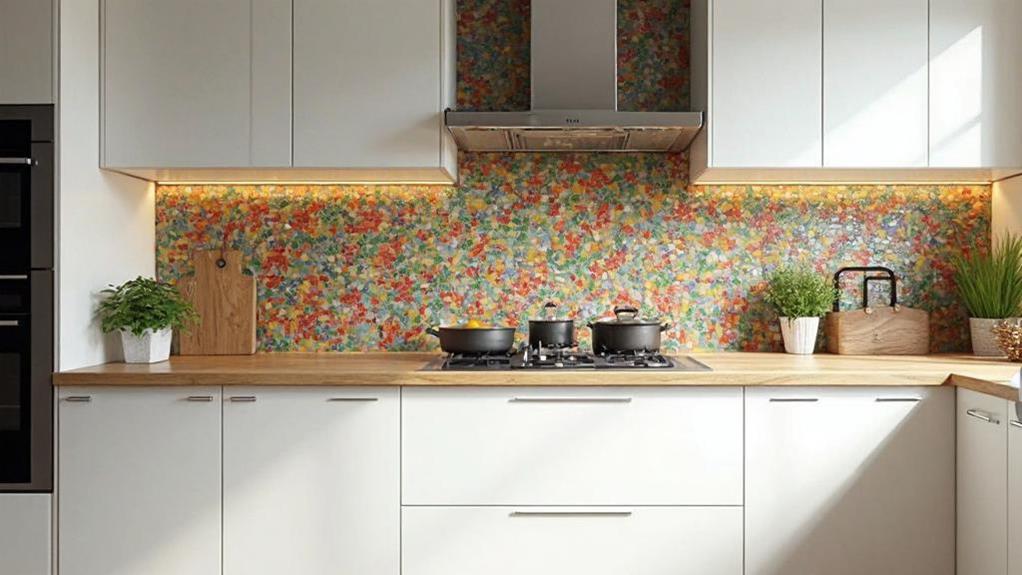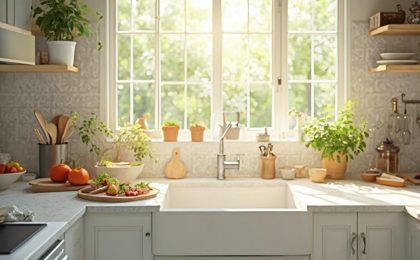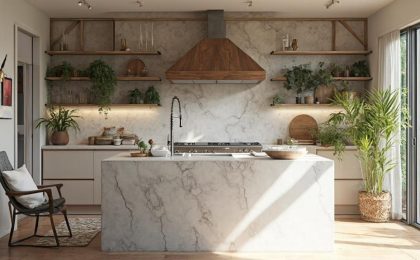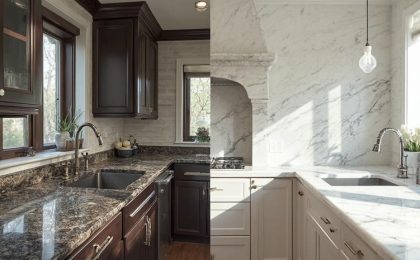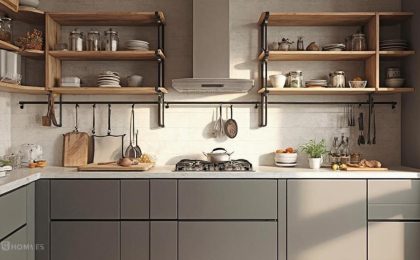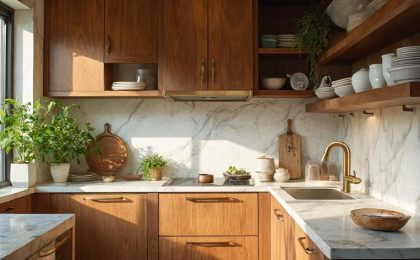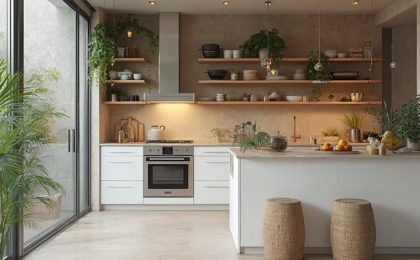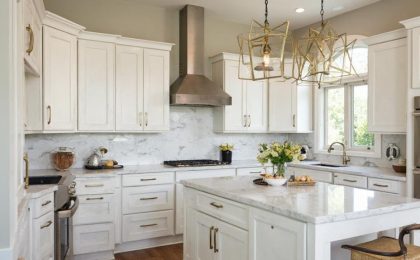When you consider kitchen design, backsplashes often get overlooked, yet they play an essential role in both function and style. They protect your walls from messes and can be a striking focal point that ties the entire room together. Choosing the right material, color, and pattern can truly elevate your space, but the options can be overwhelming. So, how do you guarantee your backsplash complements your overall design while still being practical? Let’s explore some key tips that might just transform your kitchen into a stunning culinary haven.
Key insights
- Backsplashes protect kitchen walls from stains and splatters, simplifying cleanup and preserving structural integrity.
- Choose materials like ceramic or glass for durability, moisture resistance, and aesthetic appeal in busy kitchens.
- Color and pattern selection can enhance visual interest; bold colors or geometric patterns create striking focal points.
- Consider texture and finish; glossy tiles reflect light for vibrancy, while matte finishes offer subtle sophistication.
- Decide between DIY installation for cost savings or professional help for guaranteed quality and longevity in your backsplash design.
Importance of Backsplashes
When designing your kitchen, you might overlook how essential backsplashes are for both functionality and aesthetics. These often-underappreciated surfaces serve a critical role in protecting your walls from splatters and stains, making cleanup a breeze.
You’ll find that a well-placed backsplash can shield your walls from the rigors of everyday cooking, preserving the integrity of your kitchen’s structure and finish. Additionally, professional tile fitters can help guarantee that your backsplash is installed with precision and quality, enhancing its durability and visual appeal. With comprehensive tiling services, you can achieve a stunning finish that complements your kitchen design.
But it’s not just about practicality; backsplashes also elevate your kitchen’s aesthetic appeal. The right design can become a striking focal point, enhancing the overall atmosphere.
Whether you opt for sleek subway tiles, vibrant mosaics, or rustic stone, the visual impact is undeniable. Backsplashes let you express your style, tying together cabinets, countertops, and appliances in a cohesive look.
Moreover, they can create an illusion of space or warmth, depending on your color choices and materials. With endless options available, you can easily find a backsplash that complements your theme while offering functional benefits.
Choosing the Right Material
When it comes to your kitchen backsplash, selecting the right material is key to blending functionality with style.
Professional kitchen fitters often recommend exploring popular options like ceramic, glass, and natural stone, each offering unique aesthetics and durability.
Additionally, comprehensive services offered by experienced fitters can guide you in making the best choice for your space.
Consider the maintenance needs of each material, as some require more care than others to keep your kitchen looking pristine.
Popular Backsplash Materials
A variety of backsplash materials can dramatically transform your kitchen’s aesthetic and functionality. If you’re after classic elegance, ceramic tiles are a popular choice, offering endless designs and colors.
For a modern twist, consider glass mosaics; their reflective surfaces create stunning focal points while adding depth to your space. Stainless steel backsplashes are perfect for a sleek, industrial look, blending seamlessly with appliances.
Natural stone, like marble or granite, introduces a touch of luxury, while peel and stick options provide an easy, budget-friendly way to elevate your decor without the hassle of traditional installation.
Subway tiles remain a timeless favorite, bringing a clean and structured appearance to any kitchen.
If you’re feeling adventurous, patterned vinyl can add a splash of personality, whereas concrete slabs offer a minimalist vibe.
For a rustic touch, reclaimed wood or brick veneer can bring warmth and character, making your kitchen feel more inviting.
Each material serves a unique purpose, so consider your kitchen’s overall style and functionality when making your choice.
With so many options available, you’re bound to find the perfect backsplash material that reflects your personality and enhances your culinary space.
Maintenance and Durability
Selecting the appropriate backsplash material isn’t just about style; it’s also essential to take into account maintenance and durability. When you choose a backsplash, think of it as a long-term investment in your kitchen’s functionality. The right material won’t only enhance the aesthetic but also provide surface protection against spills, stains, and heat.
Ceramic tile, for instance, offers excellent durability and is resistant to moisture and heat. It’s easy to clean, making it ideal for busy kitchens.
On the other hand, natural stone like granite or marble can add elegance but may require more upkeep, including sealing to maintain its surface protection.
Glass tiles are another option; they’re sleek and modern but can be prone to scratching. If you’re opting for metal, like stainless steel, it’s incredibly durable but may show fingerprints.
Ultimately, consider how much time you’re willing to spend on maintenance. A more durable, easy-to-clean material could save you time and effort in the long run, ensuring your kitchen remains stunning and functional for years to come.
Choose wisely, and your backsplash will serve you well.
Color and Pattern Considerations
When choosing a backsplash, bold colors can transform your kitchen into a vibrant focal point.
It’s important to take into account how complementary patterns and textures harmonize with your overall design, creating visual interest without overwhelming the space.
Incorporating features like custom design services can enhance your backsplash choices, ensuring they align with your style.
The finish you select, whether glossy or matte, will also play a significant role in reflecting light and enhancing the room’s character.
Bold Color Choices
While many homeowners opt for neutral tones in their kitchen design, embracing bold color choices can transform your space into a vibrant focal point.
By incorporating vibrant hues, you can create a striking contrast that draws the eye and invigorates your cooking area.
Here are three ways to effectively use color in your backsplash:
- Accent Walls: Choose a single wall to feature a striking color that contrasts with your cabinets and countertops. This creates a dynamic visual impact.
- Color Blocks: Use tiles in bold colors arranged in geometric patterns. This technique allows you to play with contrasting tones, making the backsplash a true work of art.
- Glazed Finishes: Opt for glossy, colorful tiles that reflect light. This not only adds depth but also enhances the vibrancy of the hues, making your kitchen feel brighter and more inviting.
Don’t shy away from experimenting with your color palette.
Whether you prefer deep blues, fiery reds, or bright yellows, bold choices can elevate your kitchen’s aesthetic, creating a space that’s both functional and visually appealing.
Complementary Patterns
Bold color choices can set the stage for exploring complementary patterns that enhance your kitchen’s design. When you choose vibrant hues, the right patterns can amplify their impact.
Consider incorporating geometric designs to create a modern feel; sharp lines and angles can contrast beautifully with softer color palettes. Mosaic patterns, with their intricate arrangements, can add depth and visual interest, drawing the eye and making your backsplash a central feature.
If you lean towards a vintage style, think about using artisanal tiles with subtle floral motifs. These can infuse warmth and character into your space, allowing you to maintain a cohesive look while still embracing uniqueness.
Mixing contrasting hues within these patterns can create dynamic visual tension, sparking interest and conversation.
As you select patterns, remember that balance is key. Too many competing designs can overwhelm the space, while the right complementary patterns will harmonize with your bold choices, enhancing the overall aesthetic.
Embrace creativity, and let your backsplash reflect your personal style, transforming your kitchen into a stunning focal point that resonates with your vision.
Texture and Finish
The interplay of texture and finish can elevate your kitchen backsplash from mere functionality to an artistic statement.
By carefully selecting texture variety and finish options, you can create a stunning focal point that complements your overall kitchen design.
Here are three key considerations to keep in mind:
- Material Selection: Consider materials like glass, ceramic, or stone. Each offers a distinct texture that can enhance your backsplash—smooth glass provides a sleek modern feel, while rustic stone adds warmth and character.
- Color and Contrast: Choose colors that either harmonize or contrast with your cabinetry and countertops. A textured backsplash in a bold hue can serve as a striking backdrop, drawing the eye and creating depth.
- Finish Effects: Explore various finish options, such as matte, glossy, or satin. A glossy finish can reflect light, making the space feel larger, whereas a matte finish can lend a more subdued, sophisticated look.
Size and Scale Impact
When it comes to kitchen design, size and scale play an essential role in determining the overall impact of a backsplash. The proportions of your backsplash should harmonize with the surrounding elements, ensuring visual balance. If your kitchen boasts high ceilings and spacious countertops, consider larger tiles or bold patterns to fill the space effectively. Conversely, in a smaller kitchen, opting for smaller tiles or a subtle design can create an inviting, cohesive aesthetic.
| Backsplash Size | Ideal Kitchen Size |
|---|---|
| Large Format Tiles | Open concept or spacious kitchen |
| Standard Tiles | Average-sized kitchen |
| Mosaic Patterns | Small kitchen |
| Vertical Subway Tiles | Tall ceilings, narrow spaces |
Complementing Other Design Elements
Choosing the right backsplash goes beyond just size and scale; it’s also about how well it complements the other design elements in your kitchen. Achieving design harmony is essential, as it creates a cohesive and inviting space.
Your backsplash should enhance the overall aesthetic balance without overwhelming other features like cabinetry and countertops.
Here are three tips to guarantee your backsplash complements your kitchen design:
- Color Coordination: Choose a color that either matches or contrasts beautifully with your cabinets and counters. This creates a seamless flow or a striking focal point, depending on your design intent.
- Material Consistency: If you’ve opted for natural stone countertops, consider a backsplash made from the same material or a complementary one. This reinforces design harmony and elevates the kitchen’s elegance.
- Pattern Play: If your kitchen features intricate cabinet designs, go for a simpler backsplash pattern. Conversely, if your cabinetry is more subdued, a bold or patterned backsplash can inject personality and vibrancy into the space.
Maintenance and Cleaning Tips
A sparkling backsplash can greatly enhance your kitchen’s aesthetic, but keeping it that way requires regular maintenance and cleaning. To guarantee your backsplash stays pristine, start with effective cleaning techniques tailored to its material.
For ceramic or glass tiles, a mixture of warm water and mild dish soap works wonders. Use a soft sponge to gently scrub away grease and grime without scratching the surface.
For tougher stains, consider a paste of baking soda and water. Apply it to the stain, let it sit for a few minutes, then wipe it away with a damp cloth. Avoid abrasive cleaners, as they can dull the finish or damage the grout.
Stain prevention is vital. Wipe down your backsplash after cooking to remove splatters before they set. For natural stone backsplashes, apply a high-quality sealant every year to protect against stains and moisture.
Regular maintenance not only preserves the beauty of your backsplash but also enhances your kitchen’s overall appeal. By incorporating these cleaning techniques and stain prevention strategies, you’ll guarantee your backsplash remains a stunning focal point for years to come.
DIY Vs. Professional Installation
Many homeowners find themselves weighing the pros and cons of DIY versus professional installation when it comes to backsplashes.
Each option has its merits, and your choice might depend on your skills, budget, and timeline.
Here’s a quick cost comparison and installation timeline to contemplate:
1. DIY Installation: If you’re handy, installing your own backsplash can save you money.
You’ll only pay for materials, which could be a fraction of the cost of hiring a pro. Just be prepared to invest time in learning techniques and executing the project.
2. Professional Installation: Hiring a professional may cost more upfront, but it often means a quicker, more polished result.
Professionals can usually complete the installation in a fraction of the time it would take you, guaranteeing a seamless finish that adds immediate value to your kitchen.
3. Skill Level: Assess your own skills honestly.
While DIY can be rewarding, poorly executed installations can lead to costly repairs. If you’re unsure, it might be worth the investment in a professional to guarantee your backsplash looks stunning and lasts for years.
Ultimately, weigh these factors carefully before making your decision.
Trendy Backsplash Ideas
As you plunge into the world of kitchen design, trendy backsplash ideas can transform your space from mundane to magnificent. One of the hottest trends right now includes vibrant mosaic designs that add a splash of color and texture. These eye-catching patterns can serve as a striking focal point, especially when paired with sleek cabinetry and countertops.
Another fantastic option is vintage tiles, evoking a sense of nostalgia while infusing charm into your kitchen. Their unique shapes and earthy tones can complement various kitchen styles, from rustic to modern.
Here’s a quick guide to inspire your selection:
| Backsplash Type | Description |
|---|---|
| Mosaic Designs | Colorful, intricate patterns that create visual interest. |
| Vintage Tiles | Timeless designs that provide character and warmth. |
| Subway Tiles | Classic, clean lines that suit any decor style. |
| Geometric Shapes | Bold, modern designs that make a statement. |
Explore these trendy options, and you’ll find that your kitchen can reflect your personal style while remaining functional and inviting. Don’t be afraid to mix and match for a truly unique look!
Frequently Asked Questions
What Is the Average Cost of Installing a Backsplash?
When you’re looking at the average cost of installing a backsplash, you’ll find that installation costs can vary greatly.
Depending on your material selection—ceramic, glass, or natural stone—you could spend anywhere from $10 to $50 per square foot.
Don’t forget to factor in labor costs if you’re not going the DIY route.
Are There Any Eco-Friendly Backsplash Materials Available?
Absolutely, there are plenty of eco-friendly backsplash materials you can choose from.
Think about sustainable materials like recycled glass, bamboo, or even reclaimed wood.
These options not only enhance your design aesthetics but also reduce your environmental footprint.
By selecting these materials, you can create a stunning visual appeal while being mindful of sustainability.
How Do I Remove an Old Backsplash?
To remove an old backsplash, you’ll need a few essential tools: a utility knife, chisel, hammer, and pry bar.
Start by scoring around the edges with the utility knife to break the seal. Then, use the chisel and hammer to gently pry off the tiles, employing careful removal techniques to avoid damaging the wall beneath.
For stubborn pieces, the pry bar can help leverage them off. Take your time, and you’ll achieve a clean removal!
Can Backsplashes Be Used in Bathrooms Too?
Absolutely, backsplashes can definitely elevate your bathroom’s style!
You can explore creative backsplash designs using tiles or glass to add a touch of elegance.
Just remember, proper backsplash maintenance is key to keeping it looking fresh. Regularly clean it with mild soap and water to prevent buildup.
Whether it’s behind the sink or in the shower, a well-chosen backsplash enhances the space and offers protection from moisture, making it both functional and beautiful.
What Are Common Mistakes to Avoid When Installing a Backsplash?
When installing a backsplash, you’ll want to avoid common pitfalls that can ruin your design.
First, don’t overlook your color choices; they should harmonize with your overall decor.
Also, pay attention to layout patterns—misaligning tiles can create a chaotic look.
Make certain to measure accurately and use proper adhesive to guarantee longevity.
Summary
Incorporating a backsplash into your kitchen design not only protects your walls but also adds a stunning visual element that reflects your personal style. By carefully selecting materials, colors, and patterns, you can create a cohesive look that enhances your space. Whether you choose to go the DIY route or hire a professional, the right backsplash can transform your kitchen into a functional masterpiece. Embrace the creativity and elevate your cooking space with a backsplash that truly shines.
